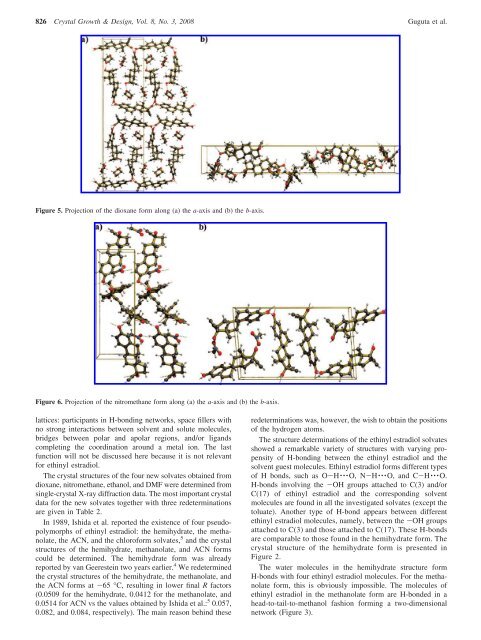Structural Diversity of Ethinyl Estradiol Solvates
Structural Diversity of Ethinyl Estradiol Solvates
Structural Diversity of Ethinyl Estradiol Solvates
You also want an ePaper? Increase the reach of your titles
YUMPU automatically turns print PDFs into web optimized ePapers that Google loves.
826 Crystal Growth & Design, Vol. 8, No. 3, 2008 Guguta et al.<br />
Figure 5. Projection <strong>of</strong> the dioxane form along (a) the a-axis and (b) the b-axis.<br />
Figure 6. Projection <strong>of</strong> the nitromethane form along (a) the a-axis and (b) the b-axis.<br />
lattices: participants in H-bonding networks, space fillers with<br />
no strong interactions between solvent and solute molecules,<br />
bridges between polar and apolar regions, and/or ligands<br />
completing the coordination around a metal ion. The last<br />
function will not be discussed here because it is not relevant<br />
for ethinyl estradiol.<br />
The crystal structures <strong>of</strong> the four new solvates obtained from<br />
dioxane, nitromethane, ethanol, and DMF were determined from<br />
single-crystal X-ray diffraction data. The most important crystal<br />
data for the new solvates together with three redeterminations<br />
are given in Table 2.<br />
In 1989, Ishida et al. reported the existence <strong>of</strong> four pseudopolymorphs<br />
<strong>of</strong> ethinyl estradiol: the hemihydrate, the methanolate,<br />
the ACN, and the chlor<strong>of</strong>orm solvates, 5 and the crystal<br />
structures <strong>of</strong> the hemihydrate, methanolate, and ACN forms<br />
could be determined. The hemihydrate form was already<br />
reported by van Geerestein two years earlier. 4 We redetermined<br />
the crystal structures <strong>of</strong> the hemihydrate, the methanolate, and<br />
the ACN forms at -65 °C, resulting in lower final R factors<br />
(0.0509 for the hemihydrate, 0.0412 for the methanolate, and<br />
0.0514 for ACN vs the values obtained by Ishida et al.: 5 0.057,<br />
0.082, and 0.084, respectively). The main reason behind these<br />
redeterminations was, however, the wish to obtain the positions<br />
<strong>of</strong> the hydrogen atoms.<br />
The structure determinations <strong>of</strong> the ethinyl estradiol solvates<br />
showed a remarkable variety <strong>of</strong> structures with varying propensity<br />
<strong>of</strong> H-bonding between the ethinyl estradiol and the<br />
solvent guest molecules. <strong>Ethinyl</strong> estradiol forms different types<br />
<strong>of</strong> H bonds, such as O-H ···O, N-H ···O, and C-H ···O.<br />
H-bonds involving the -OH groups attached to C(3) and/or<br />
C(17) <strong>of</strong> ethinyl estradiol and the corresponding solvent<br />
molecules are found in all the investigated solvates (except the<br />
toluate). Another type <strong>of</strong> H-bond appears between different<br />
ethinyl estradiol molecules, namely, between the -OH groups<br />
attached to C(3) and those attached to C(17). These H-bonds<br />
are comparable to those found in the hemihydrate form. The<br />
crystal structure <strong>of</strong> the hemihydrate form is presented in<br />
Figure 2.<br />
The water molecules in the hemihydrate structure form<br />
H-bonds with four ethinyl estradiol molecules. For the methanolate<br />
form, this is obviously impossible. The molecules <strong>of</strong><br />
ethinyl estradiol in the methanolate form are H-bonded in a<br />
head-to-tail-to-methanol fashion forming a two-dimensional<br />
network (Figure 3).
















